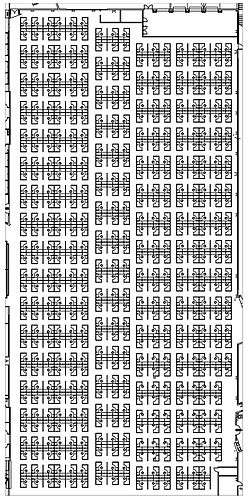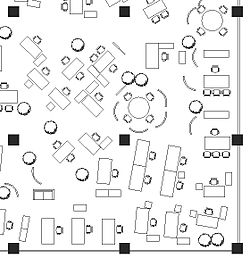The Open-floor-plan Backlash: How Family Members Are Escaping Each Other

The team-oriented "bullpen", an example of open plan in use



An information technology section in a French company in 2019.
Open plan is the generic term used in architectural and interior design for any floor plan that makes utilize of big, open up spaces and minimizes the utilise of pocket-sized, enclosed rooms such equally individual offices. The term can also refer to landscaping of housing estates, concern parks, etc., in which in that location are no defined belongings boundaries, such as hedges, fences, or walls.
Open-programme office designs are more often than not promoted every bit improving collaboration, yet some studies have suggested that moving from cubicles to open up workspaces (e.thou., tables with no visual barriers) actually results in dramatically fewer face-to-face interactions amongst staff and reduced productivity.[1]
In residential design, open plan or open up concept (the term used mainly in Canada)[2] describes the emptying of barriers such equally walls and doors that traditionally separated distinct functional areas, such every bit combining the kitchen, living room, and dining room into a unmarried great room.
Homes [edit]
Many pre-industrial homes were huts that consisted of a unmarried room, just this was normally minor. Already in the Middle Ages, notwithstanding, at that place were some single-room hearth-heated hall houses, for example in England, that were large enough so they could develop into multi-room houses. Multi-room houses however didn't become popular until later on when the land industrialized, as a outcome of which more people could afford them.
In the 1880s,[ clarification needed ] small-scale public rooms of the habitation with specific functions began to be replaced by larger rooms that fulfilled multiple uses, just kitchens, bedrooms, and bathrooms remained enclosed private spaces.[iii] Larger rooms were fabricated possible by advances in centralized heating that allowed larger spaces to be kept at comfortable temperatures.[3]
Frank Lloyd Wright was 1 of the early advocates for open programme pattern in houses,[iv] expanding on the ideas of Charles and Henry Greene and shingle manner architecture.[v] Wright'south designs were based on a centralized kitchen open to other public spaces of the habitation where the housewife could exist "more than hostess 'officio', operating in gracious relation to her home, instead of being a kitchen mechanic behind closed doors."[six] Non having a dividing wall between the kitchen and a combined living-dining room became more pop especially in the U.s.a. in the 1970s.[seven]
A home with this type of layout has one or more big, open rooms that office as multiple rooms inside a single living space. The nearly common design is a slap-up room that combines the kitchen, dining room, and living room into 1 shared infinite. Such floor plans usually work well in homes with a smaller area, while larger homes take more leeway to work with[ clarification needed ] when integrating great rooms into a flooring plan.[8] The removal of interior walls increases views and allows sunlight from windows in the outside walls to spread throughout the business firm.
In the tardily 2010s, the open plan design became less common. Complaints about open plan designs include that they arrive more than difficult for unlike people to engage in unlike activities and get in difficult to hide clutter or a muddied kitchen.[9] Walls are useful to comprise dissonance and smells and to provide privacy, and small rooms are more efficient to heat and cool (especially when kitchen appliances are in use).[vii] A follow-on trend among relatively wealthy homeowners is to build a 2d "mess kitchen" where the actual activity of food preparation takes place, while entertaining happens in a clean kitchen that is part of the open concept infinite.[7] [x]
Office spaces [edit]
Evolution of open-plan workspace types [edit]
Prior to the 1950s open-program offices mostly consisted of big regular rows of desks or benches where clerks, typists, or technicians performed repetitive tasks.[eleven] Such designs were rooted in the piece of work of industrial engineers or efficiency experts such every bit Frederick Winslow Taylor and Henry Ford. In the 1950s a High german team named Quickborner developed the part landscape, which used conventional furniture, curved screens, big potted plants, and organic geometry to create work groups on large, open floors. Office mural was quickly supplanted by office-article of furniture companies which developed cubicles based on panel-hung or systems furniture. Many terms (more often than not derisive) have been used over fourth dimension for offices using the old-style, large arrays of open cubicles.
An increment in noesis piece of work and the emergence of mobile technology during the tardily 20th-century led to an evolution in open-program offices.[12] [thirteen] Many[ quantify ] companies have started experimenting with designs which provide a mix of cubicles, open up workstations, private offices, and group workstations. In some cases, these are not assigned to one detail individual, merely are available to any employee of the company on either a reservable or "driblet-in" (first come, first served) basis. Terms for this strategy include hoteling, "alternative officing"[14] and "hot desking".
Michael Bloomberg used a team-oriented bullpen way – where employees can meet and hear each other freely, but desks are grouped into teams – at his media company Bloomberg 50.P. and for his staff while Mayor of New York City[15] (in office: 2002–2013).
Evaluation [edit]
A systematic survey of research upon the effects of open-plan offices plant frequent negative effects in some traditional workplaces: loftier levels of noise, stress, conflict, high blood pressure and a loftier staff turnover.[xvi] [17]
The noise level in open-plan offices greatly reduces productivity, which drops to one 3rd relative to what information technology would be in placidity rooms.[18] New technologies like vox-activation and mobile phones also decrease effectiveness in the open-plan setting.[19]
Some design goals of open programme offices include transparency (everyone can come across what everyone else is doing at any given moment), overcoming social silos, flattening organizational hierarchies[20] I study found employees reduced sharing of honest opinions while on phone calls in open up offices considering co-workers tin can overhear them.[21]
Although promoted as a way to encourage collaboration, speed decision-making, and increase the grouping'south collective intelligence, open up-plan offices event in a dramatic reduction in face-to-face interactions, as employees turn to digital communication, such every bit sending email messages.[one] Open-plan offices have frequently[ quantify ] been found to reduce the confidential or private conversations which employees engage in, and to reduce job satisfaction, concentration and operation, whilst increasing auditory and visual distractions.[22] [13] [23] [ need quotation to verify ]
Open-plan offices have been found to elevate the risk of employees needing to take time off for sickness.[24] Health considerations such equally COVID-xix may militate against working in open-plan offices.[25]
Some negative aspects of open plan offices tin can be addressed with interior design.[ example needed ] [26]
See besides [edit]
- Panopticon
References [edit]
- ^ a b Bernstein, Ethan Due south.; Turban, Stephen (2018-08-19). "The impact of the 'open' workspace on human collaboration". Phil. Trans. R. Soc. B. 373 (1753): 20170239. doi:10.1098/rstb.2017.0239. ISSN 0962-8436. PMC6030579. PMID 29967303.
- ^ Definition of open-concept at Dictionary.com
- ^ a b Ward, Peter (2011-01-01). A History of Domestic Space: Privacy and the Canadian Home. UBC Printing. pp. 37–. ISBN9780774841825 . Retrieved one June 2014.
- ^ Schwartz, Tony; Gomes, Jean; McCarthy, Catherine (2011-02-01). Be Fantabulous at Anything: The Iv Keys To Transforming the Style We Piece of work and. Simon and Schuster. pp. 224–. ISBN9781451639452 . Retrieved i June 2014.
- ^ Elliott, Lynn (May–June 2002). "Breaking Down Walls". Old-Business firm Journal. Active Interest Media, Inc.: 50–53. Retrieved ane June 2014.
- ^ Schoenauer, Norbert (2003-06-24). 6,000 Years of Housing. W.W. Norton. pp. 384–. ISBN9780393731200 . Retrieved 1 June 2014.
- ^ a b c The Example for Rooms
- ^ "The Pros and Cons of Open up Flooring Plans | Case Design/Remodeling". 3 April 2012.
- ^ "People in open-concept homes are realizing the walls were in that location for a reason".
- ^ "The new habitation trend: ii kitchens". Firm Cute. August xiv, 2014.
- ^ Duffy, F. (1997). The new function. London Conran Octopus
- ^ Gillen, N. Thousand. (2006). "The Future Workplace, Opportunities, Realities and Myths: A Practical Approach to Creating Meaningful Environments." In J. Worthington (Ed.), Reinventing the Workplace (2nd ed., pp. 61–78). Oxford: Architectural Press.
- ^ a b Davis, M. C., Leach, D. J., & Clegg, C. W. (2011). "The Physical Surroundings of the Office: Contemporary and Emerging Bug." In One thousand. P. Hodgkinson & J. K. Ford (Eds.), International Review of Industrial and Organizational Psychology (Vol. 26, pp. 193–235). Chichester, United kingdom: Wiley. doi:10.1002/9781119992592.ch6
- ^ "Cornell study".
- ^ Nagourney, Adam. "Bloomberg Vows to Work at Center of Things", New York Times
- ^ Vinesh Oommen (13 Jan 2009), "Why your function could exist making yous ill", Asia-Pacific Periodical of Health Management, archived from the original on February eighteen, 2009
- ^ Vinesh Oommen. "Why your office could be making yous ill: study". Asia-Pacific Journal of Health Management.
- ^ Treasure, Julian. "The 4 means sound affects us". TED.com. TED Talks. TED. Retrieved 2015-06-16 .
Y'all are one 3rd as productive in open up-plan offices as in quiet rooms.
- ^ Langston, Craig; Lauge-Kristensen, Rima (2013). Strategic Direction of Built Facilities. Routledge. p. 137. ISBN9781135138738 . Retrieved 2015-06-16 .
[...] voice-activated technology and mobile phones are increasing office noise levels and decreasing the effectiveness of existing open up-plan arrangements.
- ^ "Open Office Plans: Advantages, Disadvantages, & Research". Adventure Associates. June iv, 2015.
- ^ Wertz, Jia. "Open up-Programme Piece of work Spaces Lower Productivity And Employee Morale". Forbes.
- ^ Kim, Jungsoo; de Dear, Richard (2013). "Workspace satisfaction: The privacy-advice trade-off in open up-plan offices" (PDF). Journal of Environmental Psychology. 36: 18–26. doi:10.1016/j.jenvp.2013.06.007.
- ^ Elsbach, Thou. D.; Pratt, M. G. (2007). "Affiliate four: The Concrete Surround in Organizations". The Academy of Management Annals. i (i): 181–224. doi:10.1080/078559809.
- ^ Bodin Danielsson, Christina; Chungkham, Holendro Singh; Wulff, Cornelia; Westerlund, Hugo (2014). "Role blueprint's impact on sick get out rates". Ergonomics. 57 (2): 139–147. doi:10.1080/00140139.2013.871064. PMID 24460745. S2CID 20019920.
- ^ Richtel, Matt (vii May 2020). "Goodbye open up programme, how-do-you-do cubicles: What will offices look like after Covid-nineteen?". The Irish Times . Retrieved 28 May 2020.
- ^ Candido C.; Chakraborty P.; Tjondronegoro D. (March 28, 2019). "The Rise of Office Blueprint in High-Performance, Open-Program Environments". Buildings. 100 (ix): 100. doi:10.3390/buildings9040100.
The majority of papers establish in this Scopus search point to several shortcomings of open up-program offices, sometimes suggesting solutions to accost dissatisfaction.
Source: https://en.wikipedia.org/wiki/Open_plan
0 Response to "The Open-floor-plan Backlash: How Family Members Are Escaping Each Other"
Post a Comment